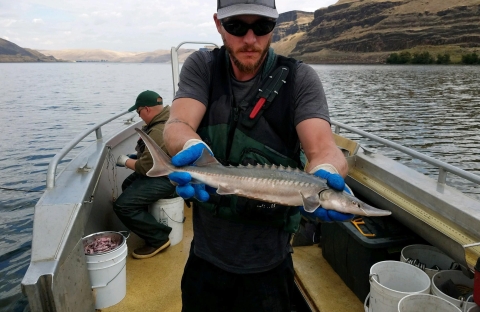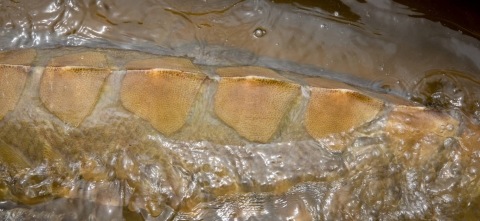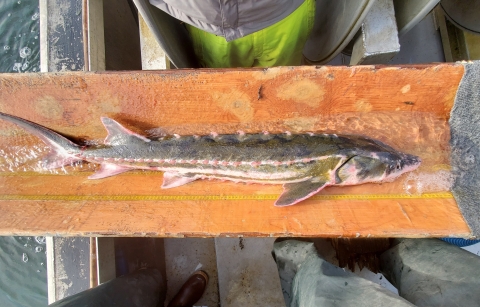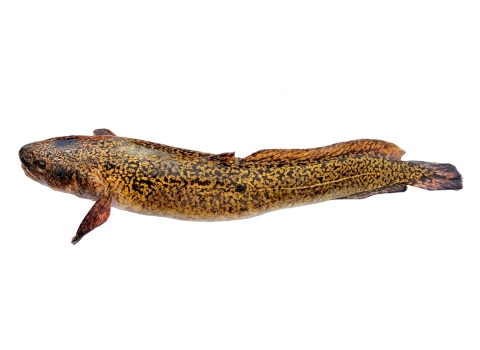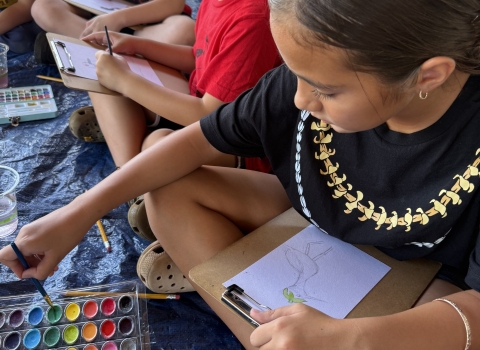Green and White Sturgeon are found throughout the major river basins on the West Coast of North America—the Columbia, Sacramento-San Joaquin, Snake and Fraser. That said, these wanderers can be found from California to Alaska in freshwater, in saltwater, and all the estuaries in between.
“Sturgeon get themselves into all sorts of interesting places.”
Big, Old Fish
Capable of reaching lengths of 20 feet, White Sturgeon are the largest fish in in North America (but 10–12 feet is considered large by today’s standards). Green Sturgeon are no size slouch either—they max out around 8 feet long but are more commonly in the 4–5 foot range. Sturgeon are also the grandmas and grandpas of the fish world, with greens living into their 70s and whites sometimes reaching the centenarian mark.
If that’s not enough, sturgeon were swimming on this earth over 200 million years — they’re living dinosaurs.
Sturgeon snoots
Sturgeon have an elongated snout and protrusible mouth—like a vacuum cleaner (no, they don’t have teeth). They lay on the bottom in dark, turbid waters and use sensory pores and whisker-like barbells to detect their prey.
Sturgeon scutes
Sturgeon have five rows of bony, diamond-shaped scales along the length of their body. These modified ganoid scales (scutes) act as armor. And they can be quite sharp, especially on younger sturgeon and Green Sturgeon (careful handling them!).
Vulnerable
Despite existing on earth for eons, sturgeon have some vulnerabilities. They mature late (around 15 years old) and don’t spawn every year. And they inhabit large river systems that have seen a lot of man-made changes in recent history that are proving expensive and extremely challenging to reverse. For these reasons, sturgeon can be vulnerable to fishing pressure and their populations are slow to respond to conservation actions.
Some populations of White Sturgeon are at risk of extirpation: Kootenai River (Endangered/USA); Upper Columbia, Kootenay, Upper Fraser, and Nechako (Endangered/Canada). Likewise, the Southern Distinct Population Segment of Green Sturgeon is listed as threatened under the Endangered Species Act and the northern DPS is considered a species of concern.
Fishing for sturgeon
In areas where sturgeon populations can sustain fishing pressure (like the Lower Columbia River below Bonneville Dam), White Sturgeon support recreational and commercial fisheries. Washington and Oregon work together to track their numbers and health each year and there are strict harvest quotas and limits in place to protect spawning and mature fish.
Typically recreational anglers use stout fishing rods with 50–80 pound test monofilament or braided Dacron line. Some dipnet smelt (a small, native fish that runs upriver in spring) to use as bait. There’s also a huge run of non-native shad in the lower Columbia River that sturgeon love to feed on.
“I’ve seen shad fishermen put all their shad on a stringer and one big sturgeon will come up and suck down the whole stringer and swim off with it.”
Sturgeon will also feed on full-grown salmon that have migrated upriver to spawn. Remember, sturgeon are built to swim long distances up big, powerful rivers. They’re big and very strong. Some people underestimate how strong their tails can be when handling them.
“I’ve known more than one angler who‘s been tail slapped by a sturgeon.”
Green or White?
These two species differ in their coloration; barbell and vent placement; and number and sharpness of scutes. If you catch a sturgeon, here are some helpful tips:
Green Sturgeon
✅ green stripe on sides and belly.
✅ pointed snout with barbels midway between mouth and snout.
✅ vent between the pelvic fins.
✅ 8–11 sharp dorsal scutes with an additional 1–2 scutes behind the dorsal fin (23–30 total).
White Sturgeon
☑️ no stripes on sides or belly.
☑️ blunted snout with barbels closer to snout than mouth.
☑️ vent behind pelvic fins.
☑️ 11–14 dull dorsal scutes (38+ total).
More Sturgeon:
New episodes of Fish of the Week! every Monday!
Get out there and live with, live from, discover and enjoy #AllTheFish
Follow us: FacebookInstagramApple Podcasts


